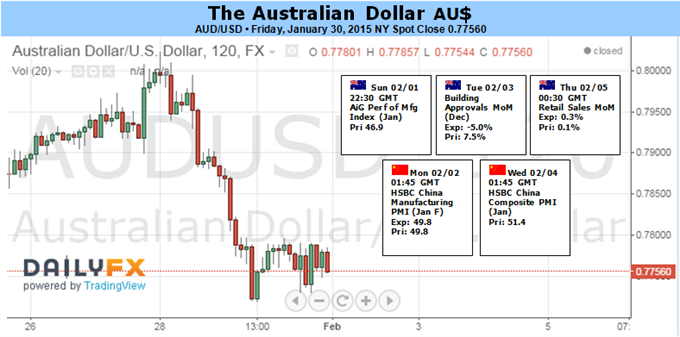
Fundamental Forecast for Australian Dollar: Neutral
- Oil-Driven Drop in Inflation Readings Fuels Interest Rate Cut Bets
- Australian Dollar May Bounce if RBA Opts Against Dovish Posture
The Australian Dollar descended to the lowest level in nearly six years against its US counterpart last week. A deteriorating monetary policy outlook looked like the leading culprit behind the move: traders are now pricing in 61 basis points in easing over the coming 12 months (according to OIS-based estimates compiled by Credit Suisse), making for the most dovish lean in traders’ expectations since early May 2013.
Furthermore, investors seem increasingly convinced that the start of the easing cycle is already at hand, with the implied probability a 25 basis point reduction at next week’s RBA meeting swelling to 65 percent. That is the first central bank sit-down to carry a greater-than-even chance of a reduction in borrowing costs in 18 months.
Fading realized and expected inflation readings seem to be behind building rate hike bets. Data published last week showed the benchmark year-on-year CPI growth rate slowed to 1.7 percent in the fourth quarter, the weakest since mid-2012. Meanwhile, Australia’s one-year breakeven rate – a measure of expected inflation derived from bond yields – has tumbled to project prices will be expanding at a pace of less than 1 percent by early 2016. That is a far cry of the RBA’s 2-3 percent objective.
The likelihood that the central bank validates the markets’ pro-stimulus posturing depends on its view of the forces bearing down on inflation. Not surprisingly, a formative factor has been the sinking price of oil. Indeed, the aforementioned CPI report showed the “transport” sub-group of index accounted for the largest downdraft in the fourth quarter, of which the most significant contribution was made by a 6.8 percent slide in the price of automotive fuel.
Faced with similar circumstances, some central banks have appeared sanguine. The Federal Reserve and the Bank of England have both chalked up recent disinflation to transitory forces that don’t necessarily have a strong bearing on medium-term price stability. Others have gone the other way: the RBNZ conspicuously backed off the hawkish rhetoric on display as recently as December in last week’s policy announcement.
Leading surveys of activity growth in the manufacturing and services sectors point to some loss of momentum since the second half of 2014 but the economy’s overall trajectory seems to remain positive. Realized data outcomes have also increasingly outperformed relative to consensus forecasts since the last RBA outing in December. If this encourages the RBA to look through near-term price declines and fall in with the Fed/BOE side of the argument – catching markets off-guard with another neutral policy statement – a swift Aussie Dollar rebound is likely in the cards.
Recommended Content
Editors’ Picks
EUR/USD edges lower toward 1.0700 post-US PCE

EUR/USD stays under modest bearish pressure but manages to hold above 1.0700 in the American session on Friday. The US Dollar (USD) gathers strength against its rivals after the stronger-than-forecast PCE inflation data, not allowing the pair to gain traction.
GBP/USD retreats to 1.2500 on renewed USD strength

GBP/USD lost its traction and turned negative on the day near 1.2500. Following the stronger-than-expected PCE inflation readings from the US, the USD stays resilient and makes it difficult for the pair to gather recovery momentum.
Gold struggles to hold above $2,350 following US inflation

Gold turned south and declined toward $2,340, erasing a large portion of its daily gains, as the USD benefited from PCE inflation data. The benchmark 10-year US yield, however, stays in negative territory and helps XAU/USD limit its losses.
Bitcoin Weekly Forecast: BTC’s next breakout could propel it to $80,000 Premium

Bitcoin’s recent price consolidation could be nearing its end as technical indicators and on-chain metrics suggest a potential upward breakout. However, this move would not be straightforward and could punish impatient investors.
Week ahead – Hawkish risk as Fed and NFP on tap, Eurozone data eyed too

Fed meets on Wednesday as US inflation stays elevated. Will Friday’s jobs report bring relief or more angst for the markets? Eurozone flash GDP and CPI numbers in focus for the Euro.